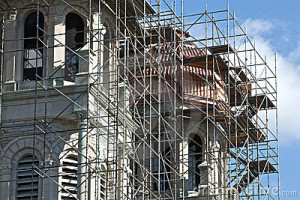Church Renovations – Safety Issues
November 27, 2012 - 3 minutes read When undertaking construction, renovations or repair jobs on or around your church’s property it’s important to be aware of health & safety requirements, and to take practical steps to reduce the risk of personal injuries and property damage from occurring. This includes ensuring that properly qualified personnel oversee or carry out repair or renovation tasks, and that all work practices are as safe as practicable.
When undertaking construction, renovations or repair jobs on or around your church’s property it’s important to be aware of health & safety requirements, and to take practical steps to reduce the risk of personal injuries and property damage from occurring. This includes ensuring that properly qualified personnel oversee or carry out repair or renovation tasks, and that all work practices are as safe as practicable.
In addition, while it might be seen as a good cost-saver to use volunteers to do the work, it’s still vital that the volunteers are either qualified to do the tasks, or that they are fully trained and supervised by a qualified person. Utilizing unskilled volunteers could result in work needing to be redone, and it is also likely to increase the risk of injury or harm occurring due to lack of expertise and experience.
Safety considerations include:
- Hot work – for work such as welding and soldering a hot-work permit system should be set up. Hot-work permits are designed to help ensure that the required tasks are carried out only by trained operators and that safety procedures are followed at all times. Contact the FPAA (Fire Protection Association Australia) for more information.
- Manual handling and lifting – proper training needs to be provided to reduce the risk of back or other musculoskeletal injury. See our article here for more information.
- Working at heights – if work needs to be done at any level above 2 metres from the ground, and the work cannot be done at ground-level, it’s vital that steps are put in place to help prevent falls from occurring. More information on working at heights can be found at WorkSafe Victoria or at your State’s WorkSafe site. For tips on ladder safety, see our article on this website.
- Asbestos – due to the risk of breathing in the fibres and contracting related illnesses or lung cancers, asbestos use has been banned since 2003. However some older buildings may contain asbestos. If asbestos removal is required during repairs or renovation, it’s essential that a professional removalist is contracted to do the job. Our article on asbestos has more information if required.
- Hazardous chemicals or vapours – due to the risk of inhaling, burns, skin irritation or other problems from hazardous substances it’s important to reduce the risk of exposure. See our separate article on chemical safety here for more details.
- Electrical safety – this is vital to reduce the risk of fire, burns and shocks. See our article here for safety tips.
Lastly, for financial protection reasons you should ensure that all contractors you use for renovation and repair work have their own liability and workers’ compensation insurance in place. To discuss any issues relating to your church’s own insurance needs and policies, contact the CCI office.
Written by Tess Oliver
Tags: construction, health & safety
Recent Comments